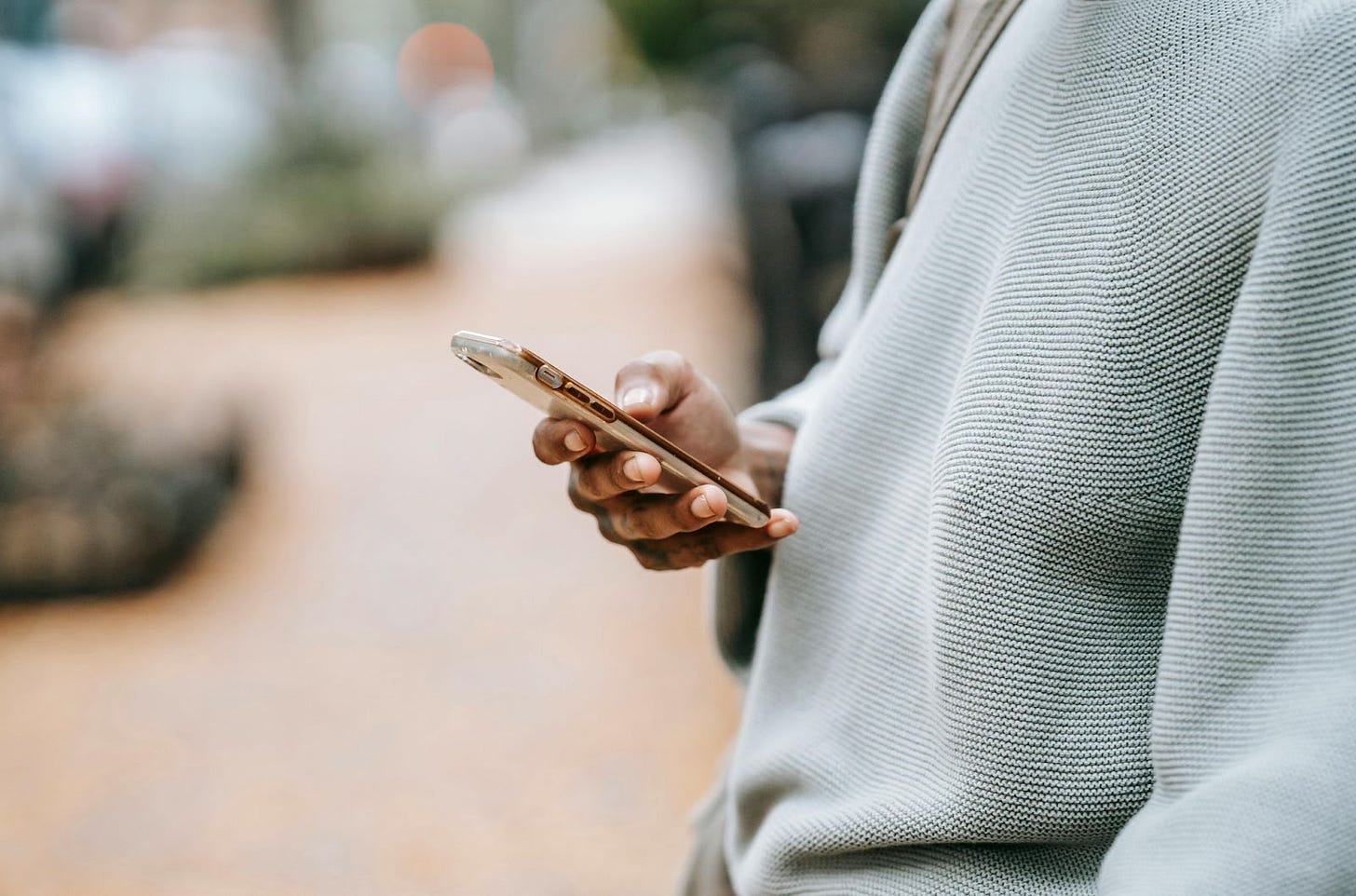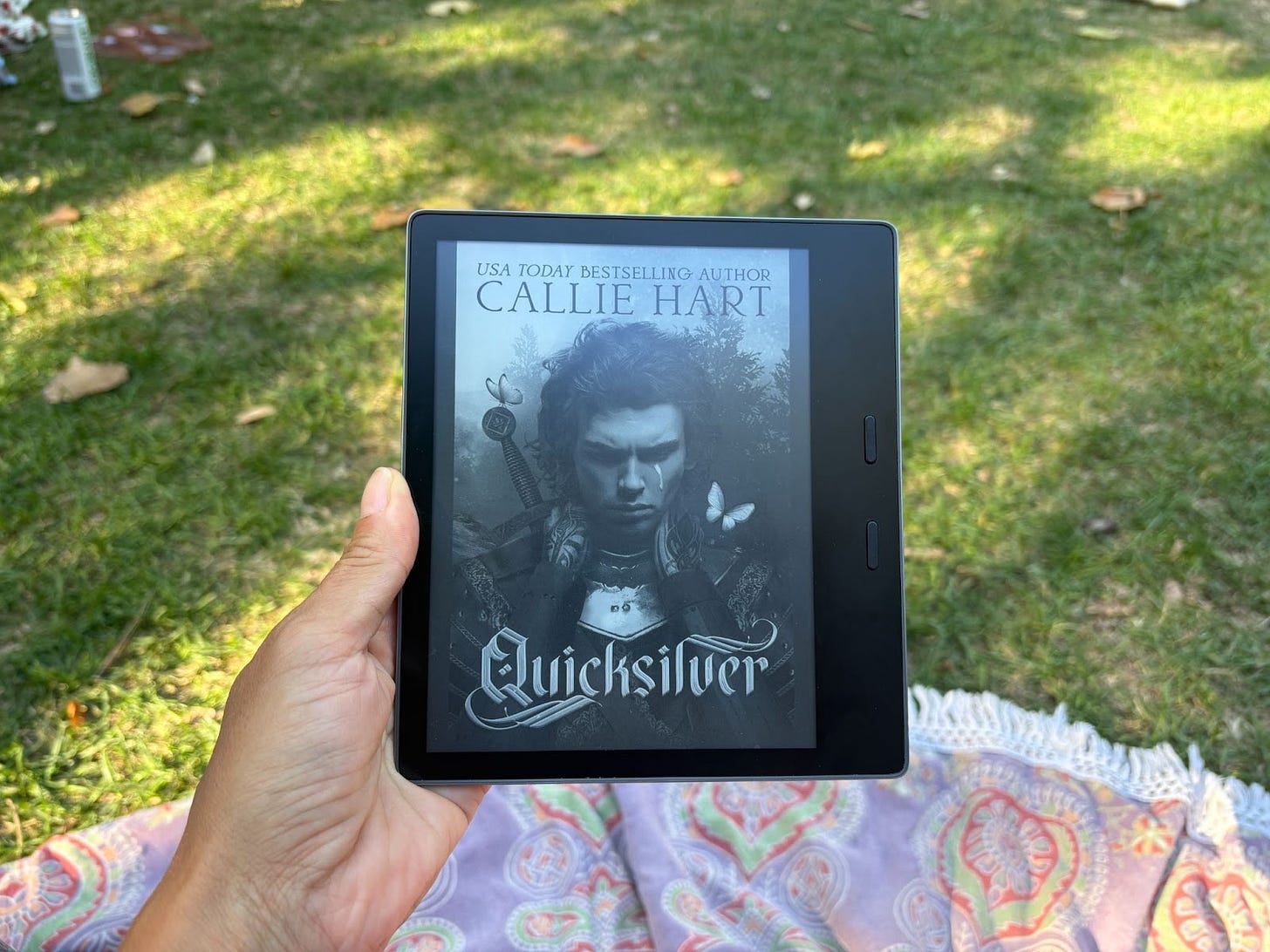#153: ☀️ Are You Wasting Your Dopamine Budget Before Breakfast?
Learn the Science Behind Morning Dopamine Hits and Which Habits Benefit Your Brain
Hey Friends,
This week I’m up in Porto to attend the NEXii Longevity Congress on October 8th and 9th.
Are you going?
Reply to this email and let’s meet up!
P.S. I recorded this episode and it’s on my YouTube Channel!
Watch it here:
💬 In this note:
☀️ Are You Wasting Your Dopamine Budget Before Breakfast?
📚Quicksilver
⚡️Workslop
#153: ☀️ Are You Wasting Your Dopamine Budget Before Breakfast?
What does your morning routine look like?
Here’s what mine looks like on a ideal day
Wake up by my Philips Hue lights turning on (I hate waking up to alarms/sound)
Walk past my phone charging in my kitchen and do not pick it up
Make a tea & light breakfast
Journal in my living room in the beam of sun that hits my dining table (If I had a cat, she would probably sit in this exact sun spot)
10-20 min meditation
Walk 15 min to the gym without sunglasses
45 min workout (Spin/Bootcamp/Barre/Yoga)
Walk 15 min home
Shower
Second small breakfast
Start my day
Here’s what it looked like yesterday
Wake up to Philips Hue lights turning on
Immediately turn them off
Sleep another 90 min
Walk past phone and immediately pick it up
Check Instagram
Make tea
Scroll through Instagram waiting for the tea
Scroll
Scroll
Scroll
Journal
Pick up phone
Scroll
Scroll
Journal some more
Forgot water bottle in bedroom - get up to get it
Walk past the clothes drying rack
Fold and put away the clothes
Ah! I forgot to meditate
Pick up the phone to choose a meditation
Get distracted looking for the meditation
Open Instagram and Linkedin
Scroll
Scroll
15 min Mediation
Breakfast
Start my day
Which morning had more “good” / “expensive” dopamine??
Morning 1.
Obviously.
With all that natural light, journaling, meditation, walking, exercise and good food.
In contrast, yesterday, morning 2, I was flooding my brain with “bad” / “cheap” dopamine, basically from the moment I woke up.
This set me up to be more distractible throughout the day.
If I start my day scrolling, I’m less engaged in my work throughout the day, more prone to reaching for my phone in a moment of boredom or distraction and spending that day more addicted to scrolling through social media.
Certain behaviors, like scrolling social media, can dysregulate your reward system over time because you are giving yourself effortless dopamine.
Your brain starts to expect high rewards for minimal efforts.
Making “expensive” dopamine rewarding activities (work, exercise, meaningful conversation) feel less satisfying by comparison.
This is why you may find yourself scrolling through social media while sitting next to your best friend or partner instead of engaging in meaningful conversation.
The main culprits for “cheap” dopamine are:
Scrolling Social Media or Doomscrolling
More on this later in the article
Checking Notifications Immediately
Each notification is a little dopamine hit.
Starting your day this way trains your brain to be reactive rather than intentional, and you’re letting external stimuli control your neurochemistry from the moment you wake up.
Pro Tip: Turn your phone to Do Not Disturb when you are sleeping, and have it automatically turn off at an hour that you’re ready to see those notifications.
For me, my DND turns off at 8am. Until then, I don’t see any notifications pop up.
Pure bliss.
Eating A Sugary Breakfast Or Drinking Caffeine Without Food
A sugary breakfast causes blood sugar spikes that trigger dopamine release, followed by crashes.
This creates a pattern of seeking more quick hits throughout the day.
I’m so so guilty of this.
Last Saturday I woke up, went to a cafe and ordered a coffee and a slice of carrot cake.
On my empty stomach.
OH MY GOD, it was delicious!
But then…for the rest of the day, I was craving sugary treats.
Hitting Snooze Repeatedly
Each time you snooze, you get a mini reward (”5 more minutes!”)
But you’re fragmenting your sleep architecture…
And you’re starting the day with a pattern of giving in to immediate gratification over long-term goals.
Not to mention - you are probably driving your partner crazy with your 15 morning alarms.
Porn Or Sexual Content Consumption
Porn is particularly potent for dopamine dysregulation because it combines novelty (endless new content), sexual arousal (evolutionarily powerful reward), and zero effort.
Having this as a morning habit is especially problematic because you’re essentially “spending” your dopamine budget before engaging with real-world challenges and relationships.
This makes everything else feel less rewarding by comparison.
Lastly, one of the worst “cheap” dopamine offenders is…
The Morning Cigarette
Nicotine directly stimulates nicotinic acetylcholine receptors, which triggers a cascade that releases dopamine in your brain’s reward center.
It’s a fast, direct hit that reaches your brain within about 10 seconds of inhaling.
The mornings are particularly problematic for a cigarette because after sleeping, your nicotine levels are 0 and your receptors are hypersensitive.
That first morning cigarette gives you one of the biggest dopamine spikes of the day.
Your brain learns to associate waking up with needing that chemical rescue, which is why morning cigarettes feel so “necessary” and satisfying to smokers.
That morning cigarette is basically hijacking your entire reward system before you’ve even had a chance to engage with your day naturally.
If you do have some of these morning routines which trigger cheap dopamine, there may be a few reasons why.
But for now…back to cheap dopamine habit #1…
Scrolling Social Media & Doomscrolling
If one of the first things you do when you wake up isn’t scrolling social media…
But scrolling through the news…
Scanning headline after headline of BIG BAD THINGS THAT HAPPENED.
In today’s world filled with wars, mass shootings, genocide, climate disasters, and increasingly polarized views, our newsfeeds are filled with distressing information.
And if you are refreshing constantly and finding yourself pulled into the horrors…
You are doing something called doomscrolling.
Doomscrolling was listed as Oxford English Dictionary‘s words of the year in 2020, when the word became popular during the pandemic when many of us refreshed our feeds to see the growing numbers of cases and deaths daily.
We are all very susceptible to doomscrolling.
The amygdala in our brain is in charge of our self-preservation and drives fight-or-flight responses to danger.
When we doomscroll, we are essentially scanning for danger.
And then stress further fuels our need to doomscroll.
The more we doomscroll, the more we feel the need to stay hypervigilant, and therefore doomscroll some more.
Women and people with a history of trauma are especially vulnerable.
Women are hit harder by doomscrolling because most violent media is about hurting women and children.
People with ADHD Are Easily Hooked by Scrolling
The ADHD brain interacts with digital content in unique ways.
Social media is designed to keep us endlessly scrolling.
However, people with ADHD may be more susceptible to this.
A paper published in 2008 linked ADHD with lower-than-average levels of dopamine.
The internet provides an endless supply of dopamine, so even if the scrolling isn’t truly satisfying, the ADHD brain still craves the next dopamine hit from the next scroll.
This can even apply when the content is negative.
While ADHD is often associated with distraction, hyperfocus on engaging content (especially negative news) is common.
Anxiety-provoking content can create a paradoxical pull to the ADHD brain, it feels urgent and important, even when it’s distressing.
What Can We Do To Break These Bad Morning Habits?
Go cold turkey on the cheap dopamine for 2-4 weeks.
This sounds brutal, but it’s necessary to let your dopamine receptors upregulate (increase in number and sensitivity).
During this time, everything will feel kind of bland and boring.
But that’s normal.
You’re recalibrating your baseline.
To help you go cold turkey on the cheap dopamine, you need to create friction for the bad habits.
Put your phone in another room at night to charge, not by your bed.
Use app blockers or delete social media apps.
Remove triggers from your environment (throw away the cigarettes, or put them out of sight)
The key is recognizing that your prefrontal cortex (decision-making) is weakest in the morning.
Don’t rely on willpower alone.
Rely on barriers that you set up the night before.
Replacing Cheap Morning Dopamine With Expensive Morning Dopamine
Pro tip: Don’t just remove dopamine sources.
Replace them with better ones.
Your brain will fight you if you just create a deficit.
Your brain needs something rewarding in the morning.
Try these six expensive dopamine morning habits:
The Cold Shower
Cold causes a massive dopamine increase (up to 250% baseline) that lasts for hours, plus it wakes up your prefrontal cortex.
Exercise
Even for just 10 minutes.
Exercise boosts dopamine, endorphins, and BDNF (brain growth factor).
Sunlight Exposure
Exposure to the sun sets your circadian rhythm.
This will regulate your cortisol awakening response and boost your dopamine production throughout the day.
Protein-rich breakfast
Tyrosine, a key amino acid in protein, is the precursor to dopamine.
Delay gratification
Wait at least 60-90 minutes after waking before checking your phone or engaging with stimulating content.
This allows your cortisol awakening response to complete naturally.
Waiting 60-90 min also allows your prefrontal cortex to come fully online.
If you wait to check your phone, you’ll have better impulse control later in the day.
This is because you don’t immediately spike your dopamine levels when you wake up.
Leverage habit stacking
Attach new habits to existing ones.
Wake up → immediate glass of water → sunlight exposure → movement
What Are Other Expensive Dopamine Habits?
In one of my morning routines, I put away the laundry, thinking that it was a good thing, rather than scrolling.
It made me wonder if cleaning or organizing triggers “cheap” or “expensive” dopamine.
Cleaning/organizing is generally considered “expensive” dopamine (the good kind), but it can become “cheap” dopamine depending on how and why you’re doing it.
Cleaning is typically expensive/healthy dopamine because you’re physically moving, making decisions, exerting energy.
Your brain has to work for the reward.
And, the satisfaction comes after sustained effort, not instantly.
You’ve actually changed your environment in a tangible way.
The dopamine comes from genuine achievement.
You also release multiple neurotransmitters.
You’re also getting serotonin (sense of control/accomplishment) and endorphins (from physical activity), not just dopamine in isolation.
However, it can become problematic, or “cheap,” dopamine when you are using compulsive cleaning as procrastination.
If you’re cleaning to avoid more important tasks, you’re basically giving yourself easy wins instead of tackling what actually matters.
The dopamine hit is real, but you’re avoiding the harder dopamine of deep work.
Cleaning also becomes “cheap” dopamine when you get stuck in a perfectionism loop.
Endlessly re-organizing the same drawer or cleaning something already clean.
This can become a compulsive behavior where you’re chasing the dopamine from “completion” without real productivity.
Or if you are using cleaning or organizing purely as a way to regulate anxiety rather than as a productive activity, it can become avoidance behavior.
What To Expect When You Change Your Morning Habits
If you’re ready to ditch the cheap dopamine and rebuild your mornings, here’s what the journey actually looks like:
Days 1-7: The Hardest Period
High cravings, low motivation.
Everything feels harder than it should.
Your brain is literally throwing a tantrum (called an “extinction burst”) trying to get you back to the old behavior.
Just survive this week. That’s your only job.
Days 7-21: Getting Easier
Still challenging, but the cravings are less intense.
Your new habits are starting to feel less effortful.
You might even notice you’re less distracted during the day.
Days 21-60: Solidifying
New patterns are taking root.
Old habits are dying.
The new routine is starting to feel natural.
60+ Days: New Baseline
Your dopamine receptors have upregulated.
Activities that felt boring before now feel satisfying.
The old habits don’t call to you the same way.
You’ve literally rewired your brain.
One Last Thing, Get An Accountability Buddy
Don’t do this alone.
Tell someone what you’re changing.
A friend, partner, or accountability buddy.
The social pressure of not wanting to disappoint someone else can provide that extra motivation when your own runs low.
Share your “perfect morning” with them.
Text them when you complete it.
Ask them to check in on you during that brutal first week of habit change.
Changing your morning routine isn’t just about willpower.
It’s understanding that you’re physically rewiring neural pathways in your brain.
And that takes time, consistency, and support.
Every morning you resist scrolling and step outside into the sun instead?
You’re strengthening new neural connections and weakening old ones.
It’s not magic. It’s neuroscience.
And it works.
So tomorrow morning, when your hand reaches for your phone, remember: you’re not just choosing how to spend the next five minutes.
You’re choosing how your brain will function for the entire day ahead.
Put the phone back down, and choose the expensive dopamine.
Want to read more about habit change?
Check out Nina’s Notes #122: 🧠 Brain Hacks for Habit Change
This topic was a reader suggestion by Dan. Thanks Dan!
Want to go beyond the newsletter?
I mentor founders and ambitious professionals who want to build resilient minds and strong bodies using evidence-based tools from neuroscience and longevity science.
Click here to learn more about private mentorship and upcoming group sessions here.
📚 Book of the Week
Rating: ★★★★☆
When I started Quicksilver by Callie Hart, I honestly thought this was going to be a three-star read.
Around 60% in, the tension between Fisher and Saeris was agonizing.
The push-and-pull, the mixed signals, the whole “I hate you but I’m obsessed with you” dynamic felt straight-up toxic.
Fisher putting magic on Saeris to keep her locked in his room and in bed (ok, she was sick and needed to heal) but still!
I nearly put the book down.
But then everything shifted.
Once they finally become lovers, their connection deepens in a way that completely changes how you see them.
By about 75% through, I realized I actually liked the book.
And I bumped my rating up to four stars.
Of course, at this point, the book is nearly over.
By then we’re already at the climax, there’s a war brewing, fairies fighting vampires, chaos everywhere.
And just when things hit their peak, Saeris has this wild, otherworldly encounter with the gods… and then it’s over.
Massive cliffhanger.
I can’t say more without spoilers, but let’s just say, that ending made me instantly ready for book two, Brimstone with the upcoming release date of November 18, 2025.
⚡️ Check This Out
Employees are complaining about “workslop.”
Workshop is “AI generated work content that masquerades as good work, but lacks the substance to meaningfully advance a given task.” (As defined by BetterUp Labs and the Stanford Social Media Lab)
Workslop looks good, but lacks substance.
It creates the illusion of progress.
Slick slides.
Lengthy reports.
Overly tightened summaries.
All that lack actual substance.
Leaving employees to do the real thinking and clean-up.
And it’s expensive!
Correcting workslop is costing large companies $9M lost productivity annually.
While AI development is moving fast, and companies are rushing to rapidly adopt AI, they are also finding that it is not directly leading to significant revenue growth.
In fact, 95% of generative AI pilots are failing at companies.
Researchers at Model Evaluation & Threat Research (METR) found that AI slows experienced open-source software developers down by 19% due to time spent prompting AI and reviewing work.
Moving too quickly or relying on it too much creates extra work and frustration especially when you’re figure out what the heck your co-worker’s meandering slideshow is about.
🗣️ Looking for the Nina’s Notes Podcast?
It’s now available on 🔴YouTube!
You can also find the Nina’s Notes podcast as always on 🟢 Spotify, 🟣 Apple Podcasts, 🟠 Substack Podcasts
On the Nina’s Notes Podcast I interview entrepreneurs who are building products based on the science that I write about in the Nina’s Notes Newsletter.
You’ll also find voice overs of all the weekly Nina’s Notes.
Thanks for reading Nina’s Notes #153. If you like this newsletter, click the share button and send it to a friend.
Edited by Wright Time Publishing








